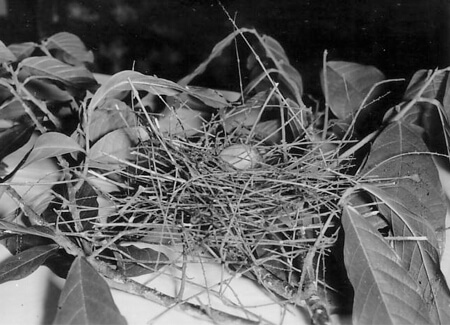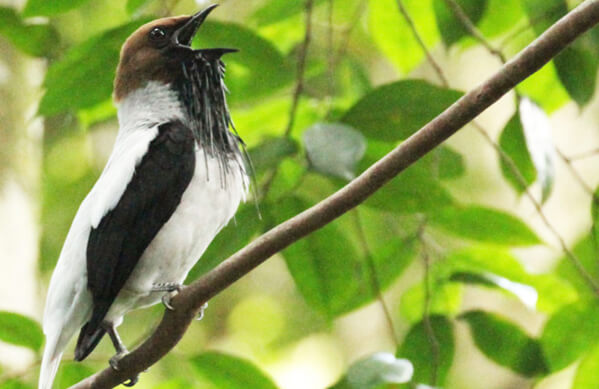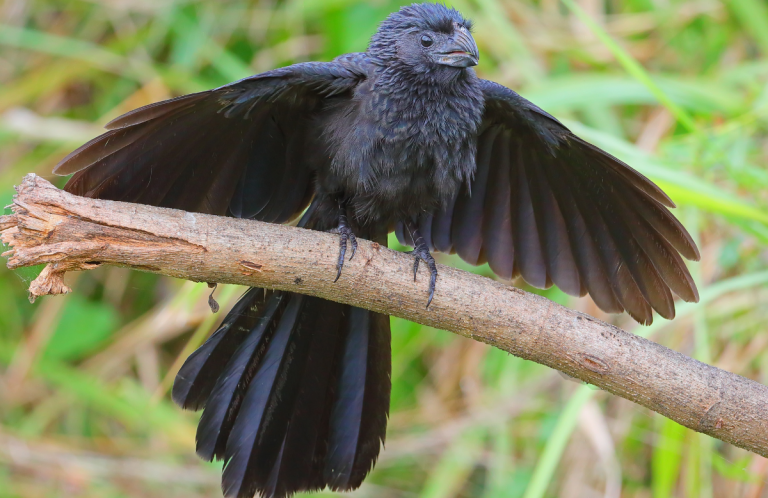 The repetitive, metallic call of the male Bearded Bellbird carries up to a half-mile away and gives it the nickname campanero (bell-ringer) or anvil-bird. Males are also notable for their snow-white plumage and black “beard”—unfeathered wattles on the throat.
The repetitive, metallic call of the male Bearded Bellbird carries up to a half-mile away and gives it the nickname campanero (bell-ringer) or anvil-bird. Males are also notable for their snow-white plumage and black “beard”—unfeathered wattles on the throat.
Bellbirds are species of Central and South America and belong to the cotinga family, which includes Hooded Berryeater and Banded Cotinga. Two subspecies are recognized, one in northern South America and one in eastern Brazil. The Brazilian subspecies is decreasing due to habitat loss and trapping for the cagebird trade.
Tree-planting Bird
The Bearded Bellbird is a fruit-eater with a wide mouth (gape) that enables it to swallow large berries. The birds feed entirely on fruit and berries, mainly plucking them while on the wing. Unlike most songbirds, which raise their young on caterpillars and insects, the female bellbird feeds her chick a diet of regurgitated berries.
This bellbird and other birds of the cotinga family are important seed dispersal agents in neotropical forests, aiding forest regeneration by spreading seed far from source trees through defecation and regurgitation.
Sign up for ABC's eNews to learn how you can help protect birds
Ear-catching Display
Bearded Bellbirds are polygamous, with males occupying a fixed territory and females selecting a mate from various males occupying an area. Males compete mainly through their distinctive, loud songs, described as an explosive “bock,” or through a second vocalization, a metallic-sounding “tonk-tonk-tonk.”
Males begin their display by calling from high, exposed branches above the forest canopy. Then they descend to a lower perch to posture and spread their tails, showing off their wattles and plumage.
After the female Bearded Bellbird selects the most impressive mate, she proceeds to build her nest in his territory. She chooses the outer branches of a free-standing tree in a semi-cleared area, probably to deter forest nest predators including monkeys, toucans, and snakes. Laying a single brown-mottled egg, the female bellbird incubates it herself, leaving the male free to continue displaying for additional potential mates.

First recorded Bearded Bellbird egg in nest. Photo by Ted Hill
Bristly Chicks
Bellbird chicks have several interesting protective adaptations. They are covered with bristly white down and roll up when disturbed so that their bill, eyes, and legs are hidden. This plumage and behavior may have evolved to mimic caterpillars covered in stinging hairs, which most predators avoid.
Chicks are rarely brooded after hatching—another strategy to avoid detection by predators that may target the nest site. Their thick down probably also provides important insulation.
Restoring Habitat for the Bellbird
The Bearded Bellbird is one of hundreds of bird species that benefits from our conservation efforts with partner SAVE Brasil. We are working to protect the most important forest fragment of northeastern Atlantic Forest—the Pernambuco area—by planting trees and protecting border areas of old-growth forest. These areas, including the ABC-supported Serra do Urubu Reserve, shelter the declining Brazilian subspecies of Bearded Bellbird as well as other threatened endemics, including Seven-colored Tanager, Pinto's Spinetail, and Golden-tailed Parrotlet.
Bennett Hennessey, ABC's Brazil Program Coordinator, notes, “In 2014, SAVE Brasil's monitoring project recorded Bearded Bellbird in Serra do Urubu for the first time in many years—a very positive sign that the species has found the habitat healthy enough to return and breed in the reserve.”
You can help: Donate today and help us take advantage of an opportunity to save some of Brazil's rarest species. Or learn more about this effort to conserve the Serra do Urubu's unique forest.
Donate to support ABC's conservation mission!



















































